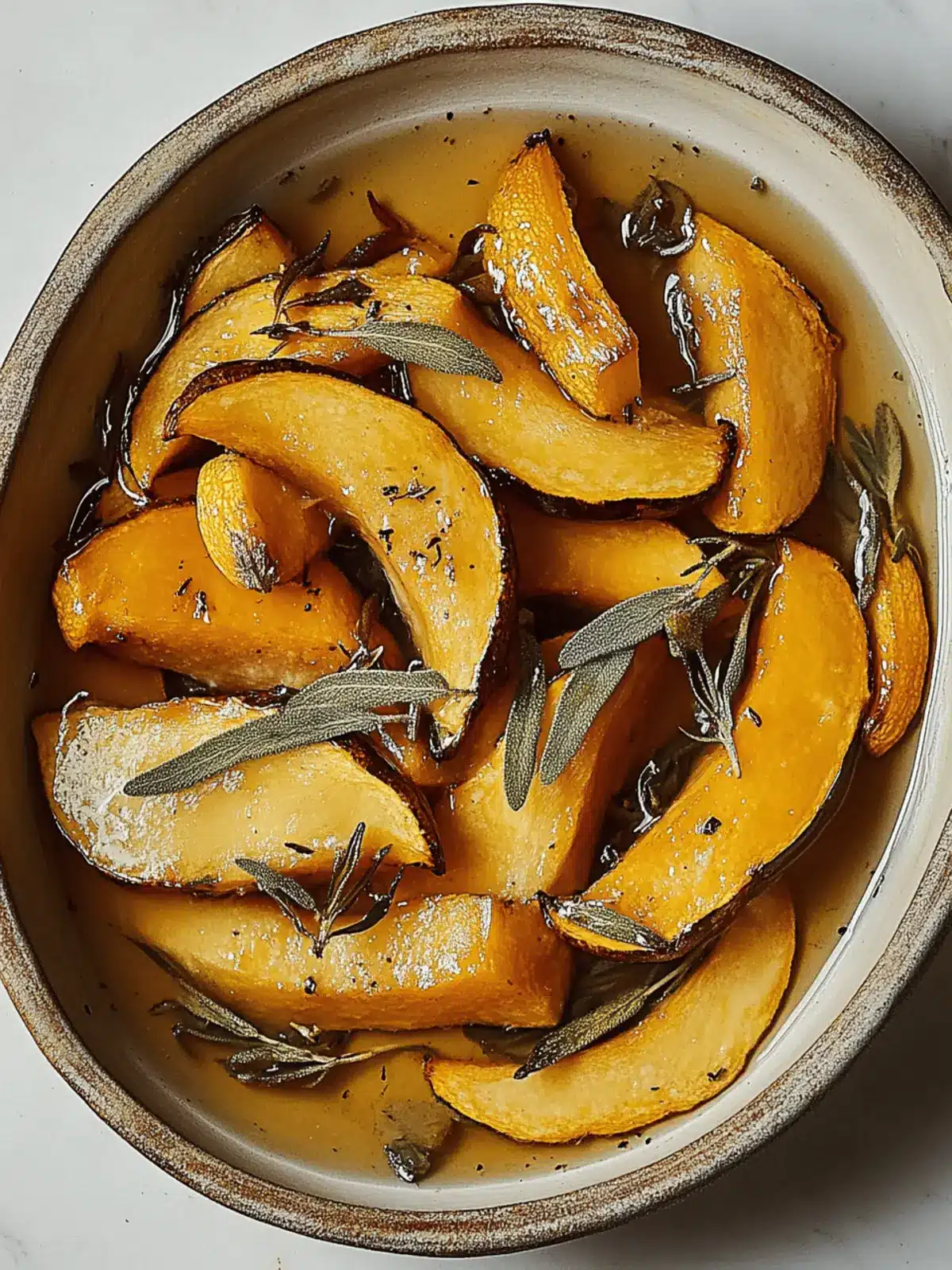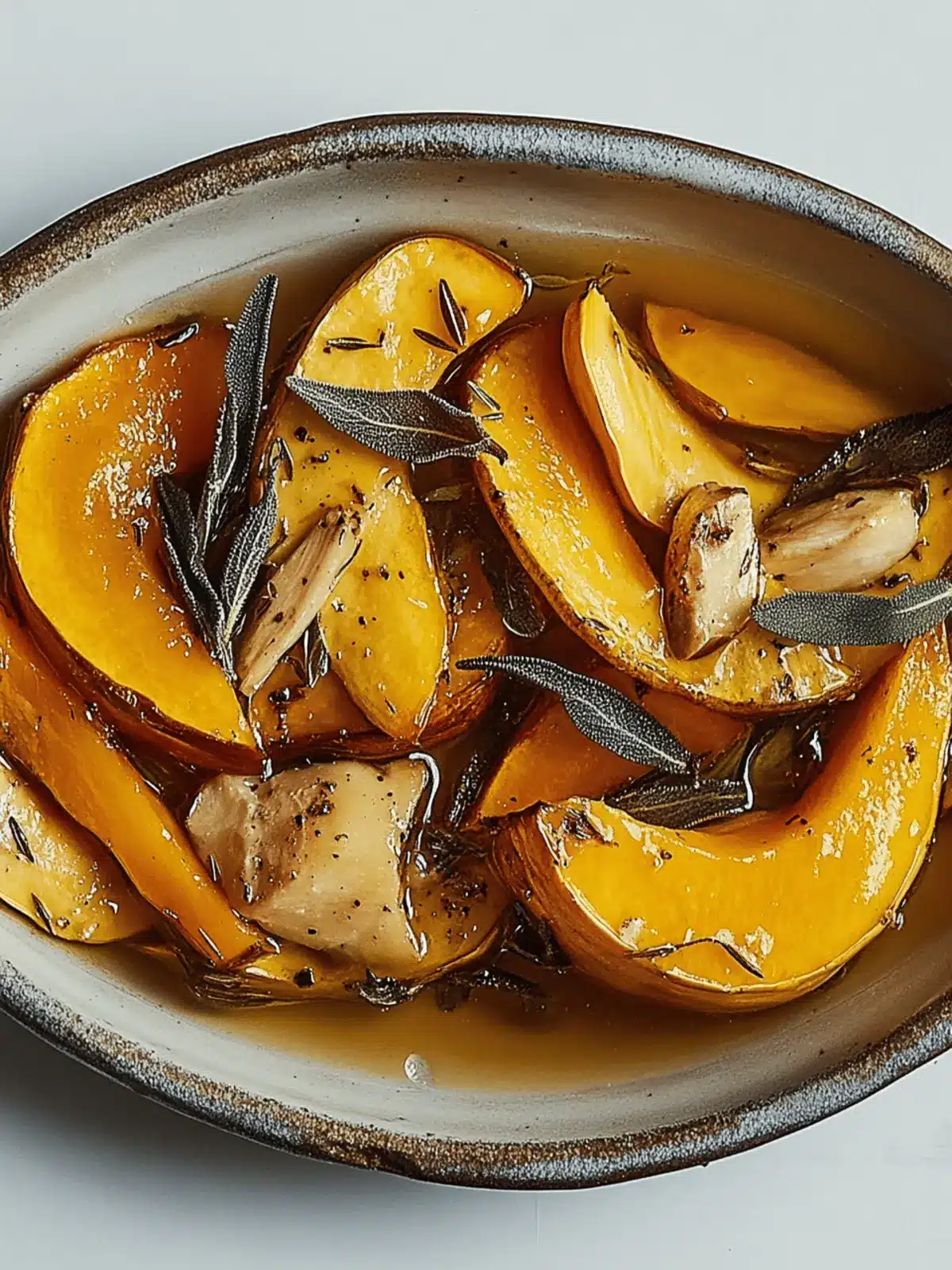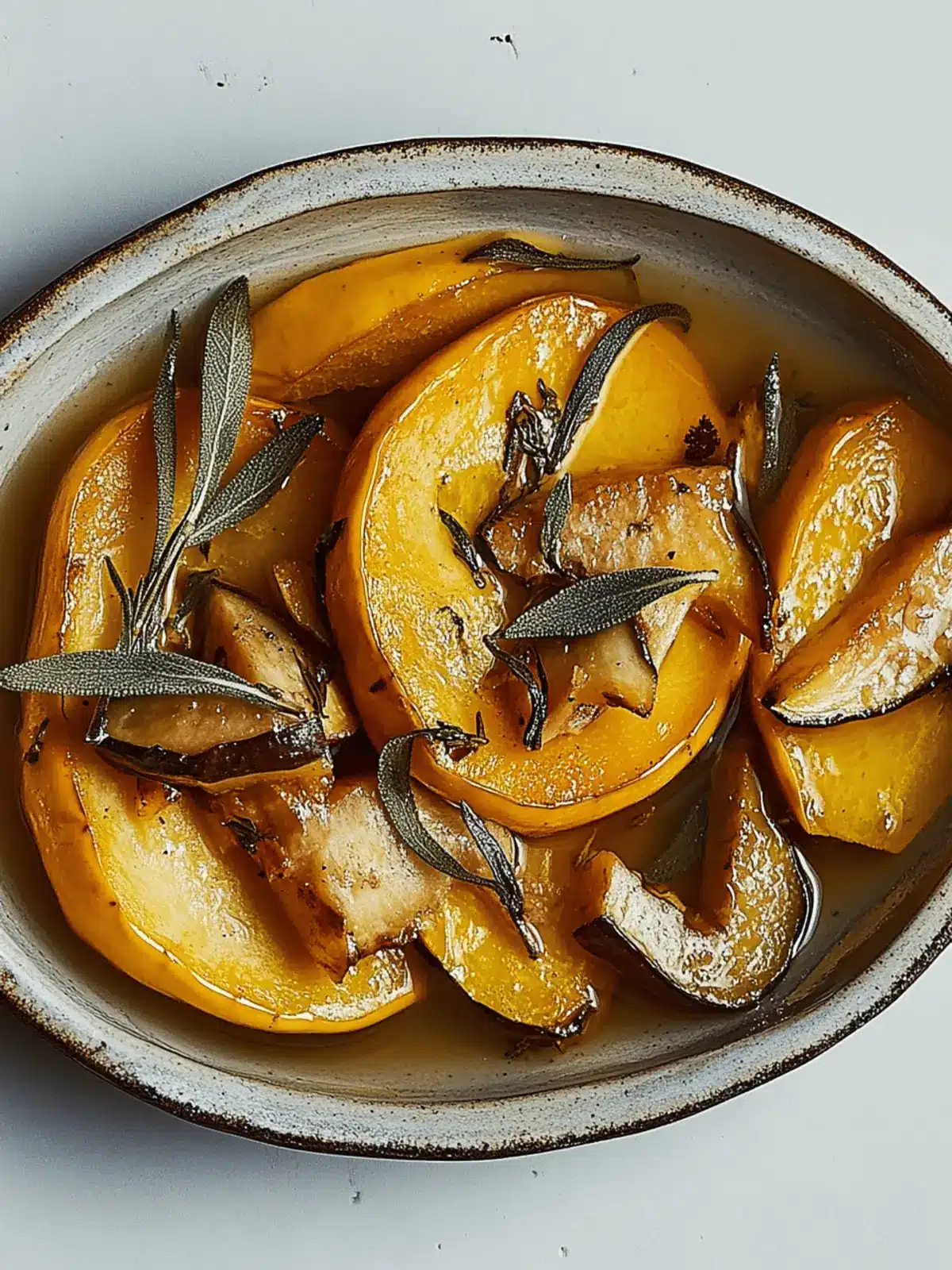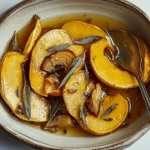As the chill of winter settles in, there’s nothing quite like filling your kitchen with the comforting aroma of Slow-Cooked Winter Squash with Sage and Thyme. Imagine an afternoon where the world slows down, and you can savor the simple pleasure of watching this earthy vegetable transform into a tender, caramelized delight. This recipe is not just a side dish; it’s a celebration of the season’s bounty, bringing a warm, inviting touch to every table.
I discovered this gem one cozy weekend while exploring different ways to make the most of winter squash we all have those moments, right? It’s so easy to grab takeout or rely on quick meals, but something about the slow-roasting process speaks to the heart and soul of home cooking. This hands-off dish allows you to effortlessly fill your home with flavor and warmth, while the delightful pairing of sage and thyme elevates the squash to a new level. Whether served alongside a holiday feast or enjoyed as a comforting main dish, you’re bound to fall in love with this nutritious, versatile recipe. Let’s dive in!
Why is Slow-Cooked Winter Squash With Sage and Thyme special?
Comforting Flavor: The rich combination of sage and thyme brings an aromatic warmth that perfectly complements the sweetness of winter squash.
Hands-Off Cooking: Simply toss your ingredients and let the oven do the work, making it an easy choice for busy weeknights or gatherings.
Versatile Dish: Enjoy it as a stunning side or a hearty main, great for both holiday feasts and casual meals.
Naturally Nutritious: Packed with vitamins A and C, this gluten-free dish is a guilt-free way to indulge in seasonal produce.
Crowd-Pleasing Appeal: The delightful aroma and caramelized edges are sure to impress your family and friends, making it a go-to recipe for any occasion!
Slow-Cooked Winter Squash Ingredients
For the Squash
- Winter Squash – Use butternut or acorn squash for the best sweetness and creamy texture.
- Olive Oil – This adds moisture and enhances flavor during roasting; you can substitute it with melted butter for a richer taste.
For the Herbs
- Fresh Sage – A robust herb that beautifully complements the sweet squash; opt for fresh over dried for optimal flavor.
- Fresh Thyme – Offers a subtle earthiness; dried thyme works too, but remember to use less since it’s more potent.
For Seasoning
- Salt – Enhances the natural flavors of the squash; feel free to adjust according to your preference.
- Pepper – Adds a bit of heat; freshly ground black pepper is recommended for the best flavor.
This Slow-Cooked Winter Squash with Sage and Thyme is not only a comforting and delicious dish but also a fantastic way to celebrate seasonal produce!
How to Make Slow-Cooked Winter Squash with Sage and Thyme
- Preheat your oven to 400°F (200°C). This initial step ensures a perfectly roasted squash that caramelizes beautifully.
- Cut the winter squash in half, scoop out the seeds, and slice into wedges. Aim for uniform pieces to ensure even cooking throughout.
- Toss squash wedges with generous amounts of olive oil, salt, pepper, sage, and thyme in a large bowl. Coat them well for maximum flavor.
- Arrange the wedges on a baking sheet in a single layer. This allows for even roasting and enhances the caramelization process.
- Roast in the preheated oven for approximately 40-50 minutes, flipping halfway through, until golden brown and tender. The edges should be slightly crispy when done.
- Serve warm, garnished with additional fresh herbs if desired. This adds a lovely finishing touch, enhancing both the flavor and presentation.
Optional: Drizzle with balsamic glaze for an extra layer of flavor.
Exact quantities are listed in the recipe card below.
Slow-Cooked Winter Squash Variations
Feel free to take this recipe on your own culinary adventure and explore a world of delicious options!
- Balsamic Drizzle: Add a drizzle of balsamic glaze before serving for a tangy contrast that brightens the dish.
- Nutty Crunch: Top with roasted nuts or pumpkin seeds for added texture and a delightful crunch that complements the squash’s creaminess.
- Herb Infusion: Experiment with other fresh herbs like rosemary or parsley to give the dish a unique twist and elevate the herbal profile.
- Spicy Kick: Sprinkle in red pepper flakes or chili powder to bring a gentle heat, creating an exciting flavor contrast with the sweetness.
- Vegetable Medley: Incorporate seasonal vegetables like carrots or sweet potatoes for enriched flavor and a colorful presentation.
- Cheesy Delight: Sprinkle with grated Parmesan or feta cheese just before serving for a savory, cheesy finish that complements the squash beautifully.
- Creamy Addition: Stir in some cream or a splash of coconut milk while the squash cooks to add a luscious, creamy element to the dish.
- Maple Sweetness: Drizzle pure maple syrup over the roasted squash for a sweet finish that balances the earthy flavors perfectly.
Expert Tips for Slow-Cooked Winter Squash
- Choose the Right Squash: Opt for butternut or acorn squash, which offers the sweetest flavor and creamiest texture when slow-cooked.
- Proper Tossing: Ensure your squash wedges are evenly coated with olive oil and seasonings; this enriches the taste and promotes caramelization.
- Don’t Overcrowd: Space out the squash on the baking sheet; overcrowding traps steam and prevents that beautiful caramelization you want in your Slow-Cooked Winter Squash.
- Check for Doneness: Use a fork to test tenderness. The squash should be fork-tender but not mushy, ensuring a satisfying bite.
- Adjust Seasonings: Feel free to tweak the salt and pepper to your liking—the balance enhances the natural sweetness of the squash beautifully.
Storage Tips for Slow-Cooked Winter Squash
- Fridge: Store leftovers in an airtight container for up to 3 days. This will help maintain the flavors and moisture of your delicious Slow-Cooked Winter Squash.
- Freezer: For longer storage, freeze in a single layer on a baking sheet before transferring to a sealed container or freezer bag. This way, it can last for up to 3 months.
- Reheating: Reheat in the oven at 350°F (175°C) for about 15-20 minutes to retain the squash’s caramelized edges. Microwaving is quicker but may result in a softer texture.
- Make-Ahead: Prepare your squash ahead of time and store it. It makes for an easy option to pull from the fridge or freezer during busy days while still enjoying that comforting flavor.
Make Ahead Options
These Slow-Cooked Winter Squash With Sage and Thyme are perfect for meal prep enthusiasts! You can cut and toss the squash with olive oil, salt, pepper, and herbs up to 24 hours in advance. Simply refrigerate the seasoned wedges in an airtight container to keep them fresh and flavorful. On the day you’re ready to serve, just spread them out on a baking sheet and roast as directed, ensuring they caramelize beautifully. This preparation saves time and effort on busy weeknights, allowing you to enjoy restaurant-quality results with minimal hassle. Trust me, your future self will appreciate this tasty make-ahead option!
What to Serve with Slow-Cooked Winter Squash With Sage and Thyme?
Complement your meal with delicious sides that bring out the best in winter squash.
- Creamy Polenta: The smooth, buttery texture pairs beautifully with the tender squash, creating a comforting contrast.
- Garlic Roasted Brussels Sprouts: Their crispy edges and slight bitterness balance the sweetness of the squash, adding depth to your plate.
- Quinoa Salad: A refreshing mix of quinoa, fresh herbs, and citrus provides a delightful contrast to the rich flavors of the squash while boosting nutrition.
- Cranberry Sauce: The tartness of cranberry sauce brightens the dish and introduces a pop of color and seasonal flair that elevates your meal.
- Roasted Chicken: Herb-marinated chicken drapes the meal in a savory richness, making it a satisfying main course option alongside the squash.
- Apple Cider: A warm glass of spiced apple cider brings a subtle sweetness that enhances the squash’s earthiness and warms the soul on chilly evenings.
- Maple Glazed Carrots: The sweetness of the carrots, roasted to perfection, harmonizes wonderfully with the herbs in the squash dish, creating a harmonious blend.
- Pecan Pie: For dessert, a slice of pecan pie brings a delightful finish, with its rich flavors and crunchy texture balancing the wonderful squash.
Slow-Cooked Winter Squash With Sage and Thyme Recipe FAQs
How do I choose the best winter squash?
Absolutely! For the sweetest and creamiest flavor, I recommend using butternut or acorn squash. Look for squashes that feel heavy for their size, with a hard skin free of dark spots or blemishes. This indicates ripeness and freshness. A firm, smooth texture is ideal!
How should I store leftover Slow-Cooked Winter Squash?
Very simple! Place leftover squash in an airtight container and store it in the refrigerator for up to 3 days. This helps to maintain its delightful flavor and moisture. It’s perfect for quick meals, just pop it out when you need a comforting dish!
Can I freeze Slow-Cooked Winter Squash?
Absolutely! To freeze, first, let the squash cool to room temperature. Then, spread it in a single layer on a baking sheet and freeze until solid, about 2 hours. Once frozen, transfer the pieces to a sealed container or freezer bag. Enjoy your delicious squash for up to 3 months! When you’re ready to eat, just thaw and reheat in the oven to bring back the texture.
What should I do if my squash isn’t caramelizing?
If your squash isn’t caramelizing, it may be due to overcrowding on the baking sheet, which traps steam, or not enough oil. Make sure to arrange the squash in a single layer and toss it well with olive oil and seasonings. Bake at 400°F (200°C) for 40-50 minutes, flipping halfway through to ensure even cooking. It should turn golden brown and tender!
Is this recipe suitable for allergies or dietary restrictions?
Great question! This Slow-Cooked Winter Squash is inherently gluten-free and vegetarian, making it a perfect option for those with dietary restrictions. For nut allergies, avoid any toppings like nuts or seeds. Also, if you’re concerned about pets, keep in mind that squash is safe for them but should be offered in moderation. Always check for individual ingredient allergens according to your needs!
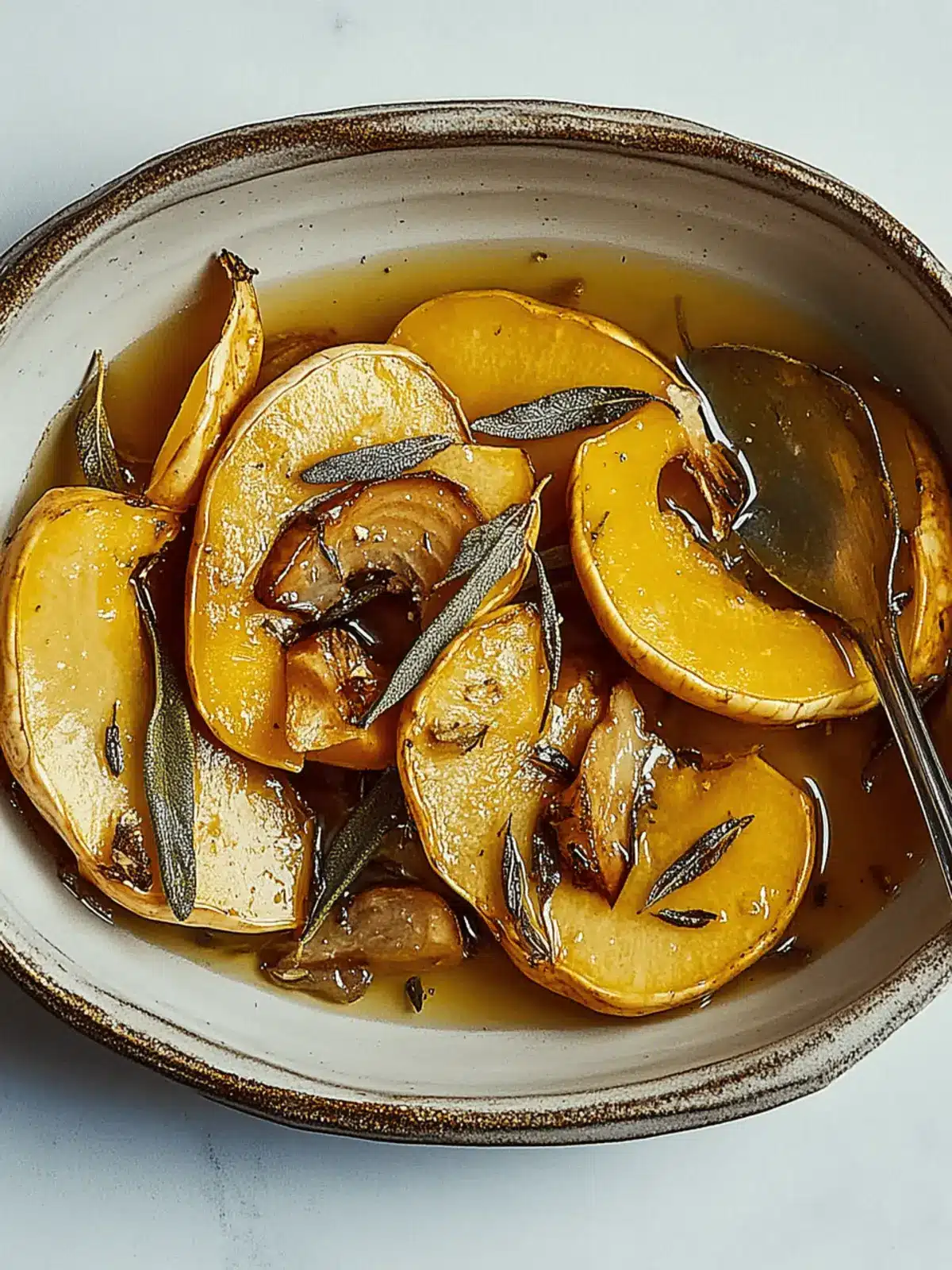
Slow-Cooked Winter Squash With Sage and Thyme: Pure Comfort Food
Ingredients
Equipment
Method
- Preheat your oven to 400°F (200°C). This initial step ensures a perfectly roasted squash that caramelizes beautifully.
- Cut the winter squash in half, scoop out the seeds, and slice into wedges. Aim for uniform pieces to ensure even cooking throughout.
- Toss squash wedges with generous amounts of olive oil, salt, pepper, sage, and thyme in a large bowl. Coat them well for maximum flavor.
- Arrange the wedges on a baking sheet in a single layer. This allows for even roasting and enhances the caramelization process.
- Roast in the preheated oven for approximately 40-50 minutes, flipping halfway through, until golden brown and tender.
- Serve warm, garnished with additional fresh herbs if desired. This adds a lovely finishing touch.

